Umbria: Itinerary in the Green Heart of Italy

Let yourself be fascinated by the magic of Umbria, the green heart of Italy. Rich in history, art, culture, and food (of course!), this region is a must-see over your trip to Italy.
Umbria Itinerary
In this Umbria itinerary, you’ll discover the beauties of this region, unique landscapes in the world, and amazing local food. Are you ready?
Bordering Tuscany, Lazio, and Le Marche, Umbria is the only region in central Italy that is not touched by the sea.
Its territory, besides a small portion of the Apennines and Trasimeno Lake, is mainly made up of velvety rolling hills covered with vineyards and olive groves.
In fact, the production of olive oil and wines, made easier by the Mediterranean climate, is the pillar of Umbria cuisine – just think that in Umbria you can find 2 DOCG wines, 13 DOC, and 6 IGT wines.
Best time to visit Umbria
The best time to explore Umbria depends on what you’re planning to do in Umbria. Here is my advice:
- Summer is ideal for those who want to discover the region by bike as this season is dry and you won’t be taken aback by storms or heavy rains.
Don’t miss Umbria Jazz in July, when Perugia streets are packed with open-air concerts.
A couple of disadvantages: it’s high season, so accommodation prices get higher, and it may get hot over the day, especially in Perugia, Terni, and Foligno.
- Spring and fall are perfect for those who want to visit the towns and villages.
Temperatures are very nice and even if it’s a rainy day you can always find shelter in a museum or..trattoria! Also, prices are lower at this time of the year as it’s the low season. Don’t miss Eurochocolate in October!
- Winter is preferred by those who are interested in religious travel since some cities like Perugia, Assisi, and Spello organize religious processions and events.
Finding Accommodation: My Tips
During your travel throughout Umbria you will find welcoming people, so take the most out of it: stay in an accommodation run by locals – they will answer all your questions about the region, what to see and eat, I can assure you that much.
Moreover, if you choose a B&B or a night-only option, you will have the chance to try typical local food in trattorias, which is something you don’t want to miss!
About This Itinerary
The itinerary you’re about to read is entirely based on my personal experience in 2021.
I had the chance of traveling all around Umbria, tasting typical food, drinking local wines, and getting to know wonderful people.
My experience was great, so here I want to share it with you adding a few tips that I learned along the way! Enjoy 🙂
1. Perugia
Did you know that Perugia is 3’000 years old? So rich in history and art, I was mesmerized by this city and its imposing ancient buildings. The atmosphere is really surreal!
Start your visit walking on the ancient aqueduct now turned into a paved street from where you can enjoy the city “in mid-air”.
Through the Arco di Via delle Volte head to Piazza IV Novembre where you’ll see Fontana Maggiore and Perugia Cathedral (Cattedrale di San Lorenzo). Walk along Corso Pietro Vannucci and discover the ruins of Rocca Paolina, where nowadays local markets are hosted.
If you’re into art, don’t miss the artworks by Piero della Francesca, Pinturicchio and many others hosted in the Museum of Palazzo dei Priori.
Furthermore, in the Cappella di San Severo, you’ll enjoy frescoes by famous Italian artists Raffaello and Perugino.
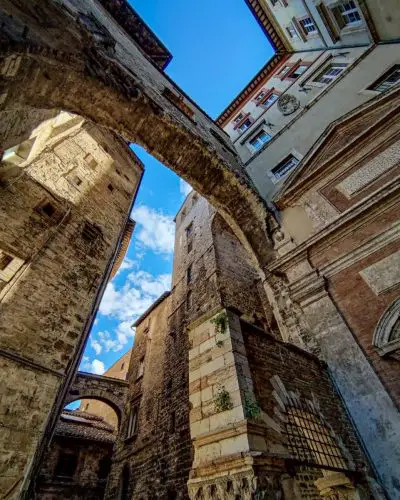
—> You may also like
2. Assisi
Just 30 mins away from Perugia is Assisi, the birthplace of Italy’s patron Saint Francis of Assisi.
Since the town is situated on the western flank of Monte Subasio, you will be able to see the majestic cathedral from below. What a view!
The Basilica of San Francesco d’Assisi is made up of three parts: the Franciscan monastery (called Sacro Convento), and the lower and upper church.
Completed in 1253, the lower church has frescoes by the late-medieval artists Cimabue and Giotto, whereas the upper church houses fresco of the life of St. Francis, supposedly painted by Italian artists from Rome.
Practical info about the Basilica
The entrance is completely free! If you’re wearing pants or sleeveless T-shirts, no worries. You’ll be given something to cover up during your visit.
While in Assisi you can also take a peek into other churches that are really worth a visit: the Cathedral of San Rufino, the Basilica of Santa Chiara, Santo Stefano, one of the oldest churches of Assisi, and the Eremo delle Carceri.
The latter, a 1’200 AC building, is 5 km away from the historic center, so you’d better take your car to reach it. You will enjoy a wonderful view of Assisi and the countryside!

—> You may also like
3. Spello
From Assisi, if you’re brave enough, you can drive on a dirt road up to Monte Subasio peak (I was riding a motorbike, but by car is doable anyway), where you will enjoy the greatest view of your trip so far, in the company of..cows!
Go along the dirt road, go past Collepino and you’ll arrive in Spello, a cozy borgo full of flowers and magnificent views. It’s tiny but very cute.
Every year Spello inhabitants organize the famous “Infiorate” which is a manifestation taking place on the occasion of the Corpus Domini feast, on the 9th Sunday after Easter.
On that night, about a thousand people work non-stop to create giant carpets made of flowers collected in the wild.
Even though leaves and berries are permitted, petals, either fresh or dried, are preferred, while it’s forbidden to use wood or any type of synthetic materials.
The hamlet’s narrow streets are then covered with floral creations. The result is unique!
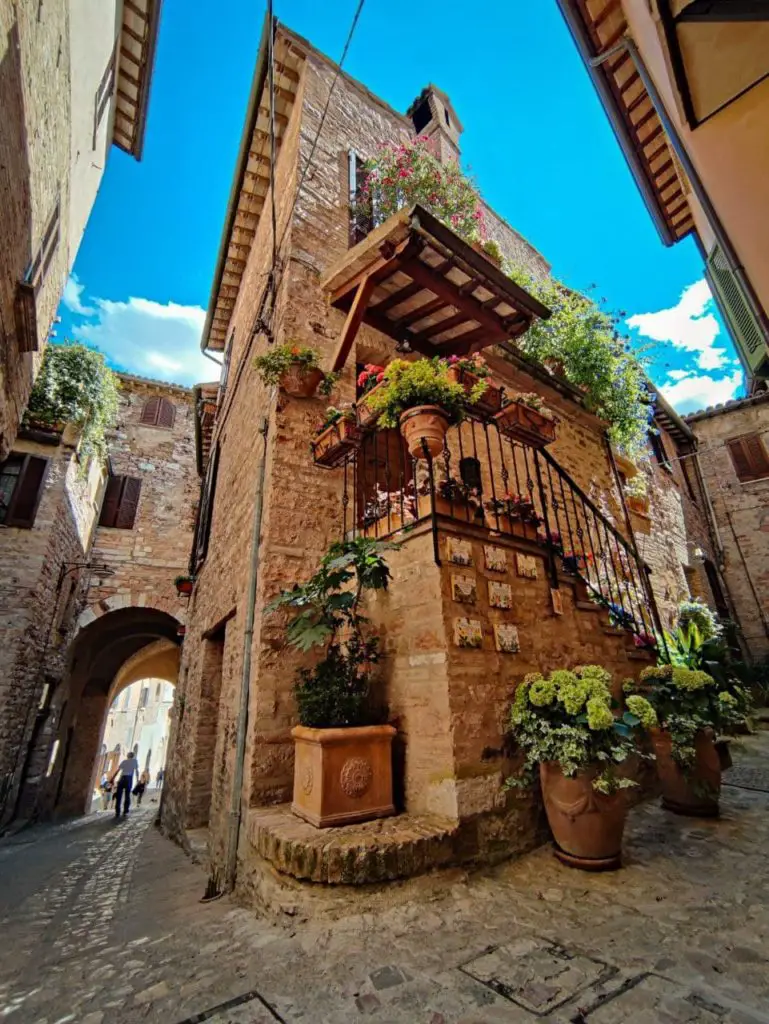
4. Spoleto
Not far from Spello is Spoleto, famous for its Festival dei Due Mondi, where Spoleto’s culture and international artists meet once a year and display their abilities on the stage.
Landmarks of Spoleto that you cannot miss are:
- the Roman theater, largely rebuilt;
- the Roman amphitheater, dating back to the 2nd century;
- Fontana del Mascherone and Ponte delle Torri, a striking 13th-century aqueduct;
- the majestic Rocca Albornoziana fortress (1359-1370) built for Cardinal Albornoz;
- the Romanesque Cathedral of S. Maria Assunta and San Pietro church, the latter with a remarkable Romanesque façade added in the 15th century.
- the Roman house, dating back to the 1st century, where its beautiful mosaic floors are still preserved.
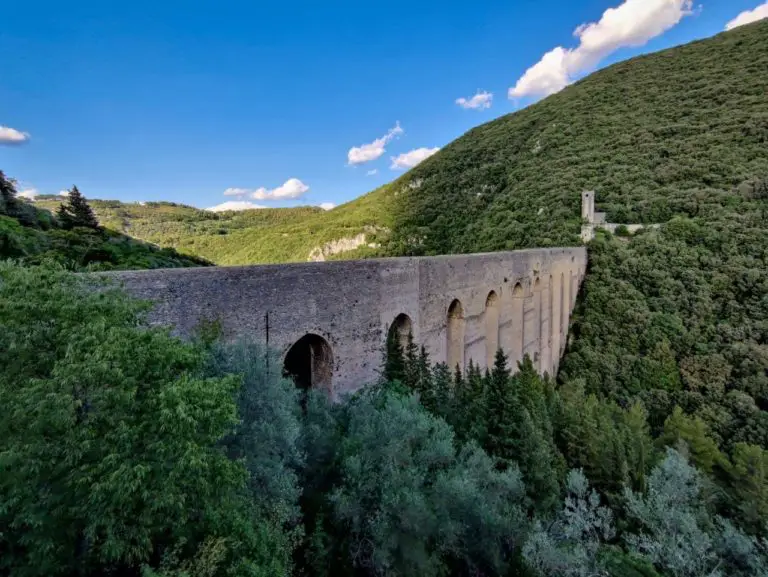
—> You may also like
Tourist Tax in Italy: the 2023 Full and Complete Guide with All Rates
5. Todi
Less than 1 hour away from Spoleto is Todi, a splendid small town definitely worth your time.
To reach the historical center drive along the XIII century walls: the panorama is astonishing.
The surrounding hills are painted with golden colors and, all of a sudden, before your eyes you will see Santa Maria della Consolazione, a most beautiful example of a Renaissance-style church. The only drawback of getting there after sunset is that the church is closed – still, the view is wonderful.
Check opening times here.
Find parking in Piazza del Popolo, where you’ll see Todi Cathedral, a Roman Catholic church dedicated to the Annunciation of the Virgin Mary.
The cathedral is the symbol of religious power, whereas the political power, as in all medieval towns in Italy, is represented by Palazzo dei Priori, Palazzo del Capitano, and Palazzo del Popolo – the latter hosting the civic museum.
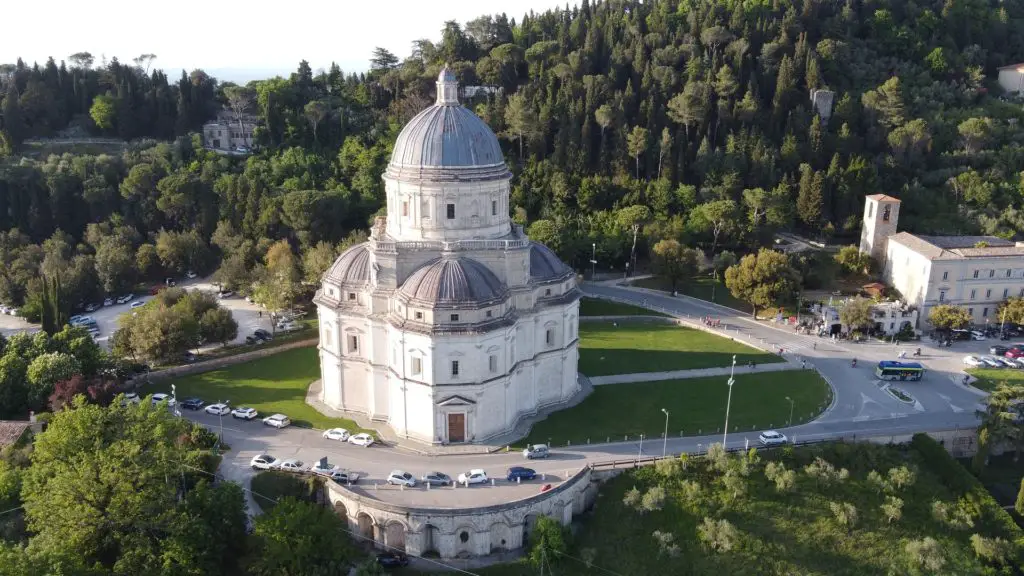
Go back towards the walls: go past San Fortunato church, a beautiful example of a Gothic and Renaissance style church, and reach the terrace on Viale della Consolazione.
I stayed there for a while to enjoy the gorgeous view of the hamlet on the hills and its magnificent surroundings.
What else should you do in Todi? I was there for very little time, but the Borgo is small and the landmarks are few.
What I enjoyed the most about Todi was strolling in the narrow streets and just enjoying the atmosphere.

6. Orvieto
You will be impressed by the city even before reaching it: fall under the spell of this town perched on a tuff hill.
Orvieto is indeed a treasure trove of art: well-known because of its Cathedral, whose building started in 1290 but continued until the second half of the 16th century. You will be amazed by its façade – the bas-reliefs represent stories from the Old and New Testament and the Final Judgment, the rose window is surrounded by magnificent mosaics – as well as by its interiors.
Certainly, you don’t want to miss the two chapels: the Chapel of the Corporal and the Chapel of San Brizio, great Renaissance-style works of art. The frescoes were painted by Beato Angelico, Benozzo Gozzoli (also famous for Pisa’s Campo Santo frescoes) and Luca Signorelli, who completed the chapel. Astonishing work! Make sure you dedicate some time to this chapel.
The Museum of the Opera del Duomo of Orvieto is also worth a visit and it’s comprised in the ticket (€ 5.00), which also includes the following:
- Palazzo Soliano – Emilio Greco Museum
- Papal Palaces – The Rooms
- Libreria Albèri
- Sant’Agostino and Santi Apostoli churches

Take a stroll in Orvieto streets and reach Saint Patrick well. Built in 1527, the well had the goal of ensuring the water in Orvieto at any time of the year.
The well is 62 meters deep, entirely dug into the tuff, and reaches the water found under the cliff on which Orvieto is built.
What’s interesting about this structure is the double helical staircases, one for the descent and the other for the ascent. This made loading water easier, thanks to the work of mules. Are you ready to go down 258 steps (and then go back up)?
Just beside the well is the Albornoz Fortress: destroyed and rebuilt several times (the last in 1450 when Orvieto was subjected to the papacy), it’s a nice viewpoint on the valley.
—> You may also like
7. Cascata delle Marmore (Marmore Falls)
You can see the falls from the main street, an astonishing view! Ideal for families as the park is child-friendly, but great for adults as the waterfall is really impressive.
My advice? Go up by taking path 1, then go back exploring the other two paths 2 and 3. Path 4 is also nice to take, if you want to take a pic having the waterfall in front of you, whereas paths 5 and 6 are not really panoramic.
Bring a k-way if you don’t want to get wet (in summer is nice, but I wouldn’t recommend it in winter!) and make sure you’re wearing sneakers or sandals that won’t make you slip.
For more info visit the official website.

—> You may also like
8. Castelluccio di Norcia
I honestly don’t know what words to use to best describe this place.
It’s been simply one of the best experiences of my life.
Imagine you’re driving up the hills and suddenly, at the last bend, you see Sibillini mountains surrounding Pian Grande, with Mount Vettore standing out and guarding the huge plain where lentils blossom offering us a spectacle of nature without equal.
Want a preview? You can see some pics here.
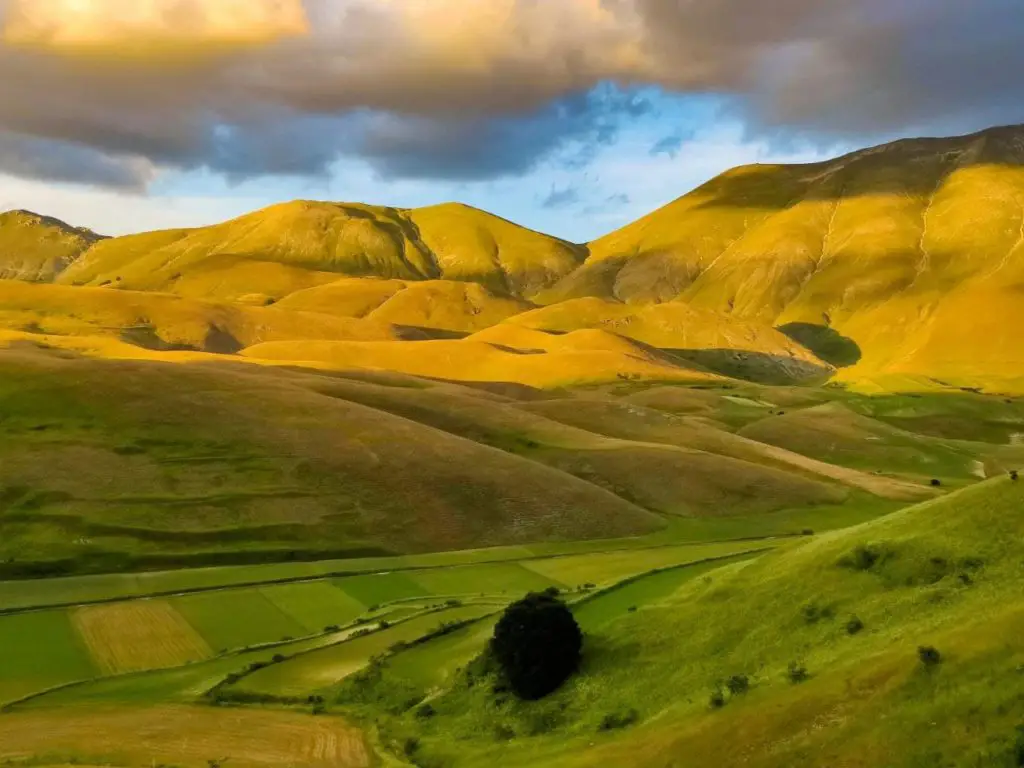
Castelluccio di Norcia accessibility
Before getting in your car, please check here that you can drive up to Castelluccio di Norcia.
Btw, by motorbike and bike, there is no problem: you can access the area at any time and from any road.
After the earthquake in 2016…
To support the local community, I suggest you stop by one of the bars and restaurants to enjoy a nice beer made from lentils (birrocchia!) or buy some of the legumes that are grown in Castelluccio: lentils, cicerchia (grass pea), beans, barley, roveja, spelt.

9. Gubbio
Gubbio is another jewel of Umbria. You must know that this town is strictly linked to a chapter of Saint Francis’s life, specifically the encounter with the wolf near Santa Maria della Vittorina church.
Just strolling down the narrow streets is really something worth the visit. Plus, in Piazza Grande, you’ll enjoy a beautiful view of the country below.
Piazza Grande together with the Palazzo dei Consoli and the Palazzo del Podestà make up one of the most majestic building projects carried out in the Middle Ages, displaying the ambitious nature of Gubbio’s political characters.
Walk a few mins to take the cableway up to the Basilica of Sant’Ubaldo, a Roman church atop Mount Ingino.
The Basilica itself may not be as beautiful as other cathedrals you’ve visited, however, if you follow the signs of the “Rocca”, you’ll get to the peak of Mount Ingino and will see a breathtaking view (see my pic below) of the hills and towns below.
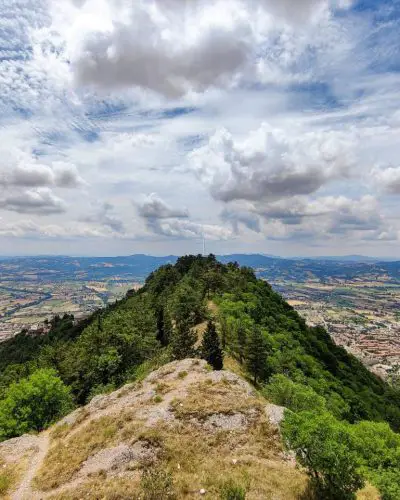
Walk down to the historical center again to see the Bargello Fountain, also called “Fontana dei pazzi” (“the fountain of the madmen”).
This fountain has become so popular thanks to a funny legend according to which a person can gain the license of “matto di Gubbio” (“madman of Gubbio”) if they run three times around it and are baptized with its waters!
Before saying goodbye to Gubbio, I stopped at the Roman Theatre, an open-air theater built in the 1st century BC. Don’t miss it!
10. Castiglione del Lago
After your visit to Gubbio, head to one of the Orange Flag towns in Italy. Castiglione del Lago is a lovely place to spend the evening and is just 1-hour drive away from Montepulciano, Tuscany.
Founded by Touring Club Italiano, the Orange Flag is a symbol of excellence awarded to towns, villages, and hamlets that not only have cultural, historical, and environmental heritage but also offer tourists a high-quality welcome.
Castiglione del Lago is named after the medieval fortress built in the 13th century and called “Castello del Leone” (literally “castle of the lion”) because of its pentagonal shape inspired by “the Lion” constellation.
The fortress is still known as Rocca del Leone, famous for its triangular tower.
Events in Castiglione del Lago
If you happen to be in Castiglione in May you will see the sky painted in rainbow colors at the “Coloriamo i Cieli” festival, thanks to the work of kitesmen teams.
This event has the purpose of spreading values such as peace and environmental protection, that’s why it was awarded the title of Heritage of Italian Traditions in 2011.
In July you will enjoy the Trasimeno Blues, a blues festival, while in August the Rassegna Internazionale del Folklore (International Folk Festival) takes place, promoting cultural exchanges between different countries.
Images credits: Michele Mora
